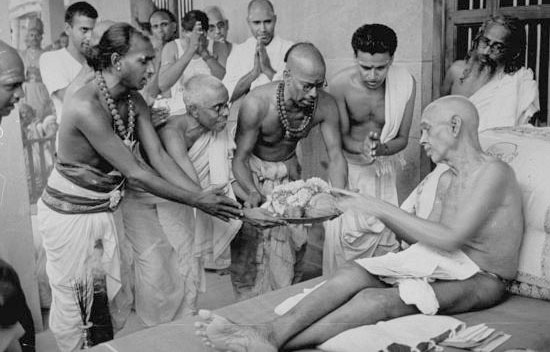Prior to entering the Ramakrishna Mission in 1947, Ramaswamy had felt something drawing him north toward the Himalayas. He had made the decision to leave South India and journey to Rishikesh in the Himalayan foothills. He had heard about the illustrious sage Sri Swami Sivanandaji Maharaj, who had an ashram on the banks of the Ganges. Ramu deeply felt the wish to have darshan of this holy being. Unfortunately, an outbreak of political riots plagued the country at that time and caused the blocking of all passages north of Benares. Ramu postponed his Himalayan trip.
After his pre-sannyas initiation and subsequent stay at the Ramakrishna Mission, in early 1949, Ramu (now Sambasivam Chaitanya) was inspired to spend some time at Ramanashram, the ashram of the great sage Ramana Maharshi, who was born in 1879 in South India. At the age of seventeen he had an experience that changed his life. One day he was overcome with a violent fear of death and began to contemplate the source of this fear. Within the same day, this self-inquiry brought him to the experience of enlightenment. When he got this knowledge directly he was able to experience the Self as different from the body. He never went to any teacher to learn this. He got it directly.
Sambasivam felt blessed to be able to sit at the feet of this jivanmukta (living liberated being). To ask the Master a question was to receive a lesson in the thinking of a true Jnana Yogi. “Who is asking this question?” Sri Ramana replied to Sambasivam’s inquiry. “Who is having the doubt?”
“Sir, I am having the doubt,” the young brahmachari answered.
“Who are you?” Sri Ramana persisted. “Find out the answer and come to me then.” Suddenly Sambasivam felt the impact of his meaning and vowed that he would find the answer to that question.
During the time that Sambasivam was staying at his ashram, Sri Ramana’s body was suffering from cancer, but the sage obviously was not disturbed by the ravages of the disease. It was not so easy for the disciples to transcend that bodily consciousness, however, and they were greatly pained to watch his body’s physical deterioration. When he saw the sad faces around him, Sri Ramana would say, “What kind of Yoga is this? Where is your proper understanding? The body is simply undergoing its karma. Why do you worry?” Sambasivam was among those who witnessed the operation that was performed on Sri Ramana’s arm. The Yoga master was not interested in having the operation, but at the insistence of his close disciples he finally agreed. Still, he refused anesthesia. As the doctor operated, Sri Ramana watched and spoke to his arm as if it belonged to someone else: “Poor arm, is the operation hurting you? Well, just undergo whatever is necessary. I don’t know what the karma was that makes you have to suffer. I told them not to do this to you, but they insisted on it. The best thing is just to accept it.”
At that time Sambasivam found all this too difficult to watch. His heart went out so much to the sage’s bodily suffering. As the cancer spread through that body, Sambasivam finally approached Sri Ramana. “Please, I beg you, Sir, to give me leave to travel on.”
“Why? Are you still attached to the body?”
“No. I’m not attached to my body, but maybe I’m attached to your body. I find it hard to face this situation. I don’t really feel comfortable in staying and watching the whole thing.”
Sri Ramana understood. He raised his hand in blessing. Sambasivam now was ready to continue his journey and headed toward Rishikesh, in the Himalayas. Fourteen days later, on the day he reached Rishikesh, Sambasivam heard that Bhagavan Ramana Maharshi had left his body. On that day many people saw a beautiful bright star flash across the sky.

Recent Comments